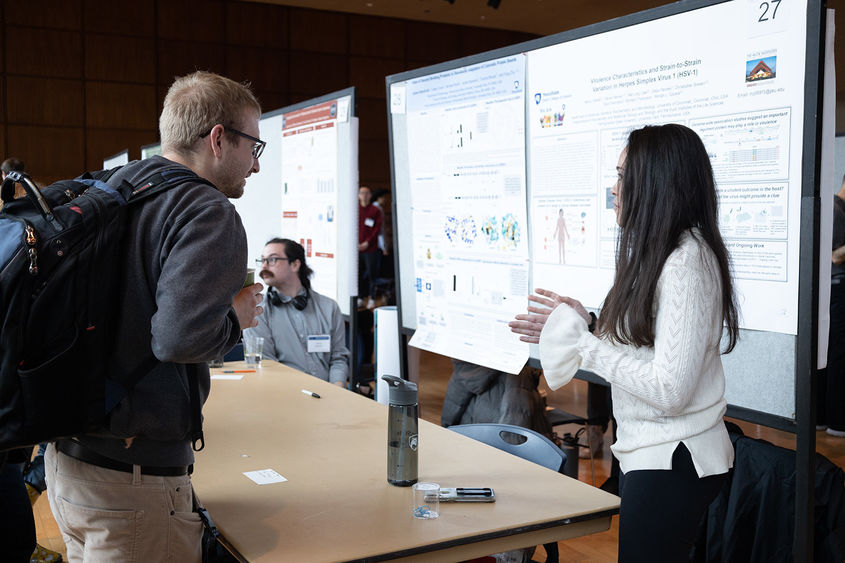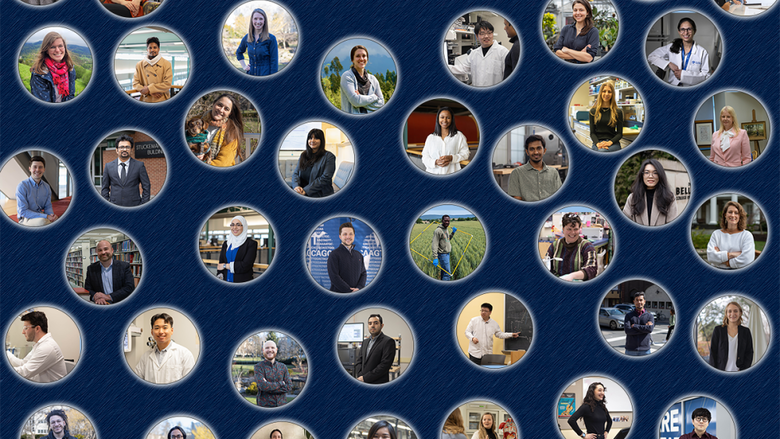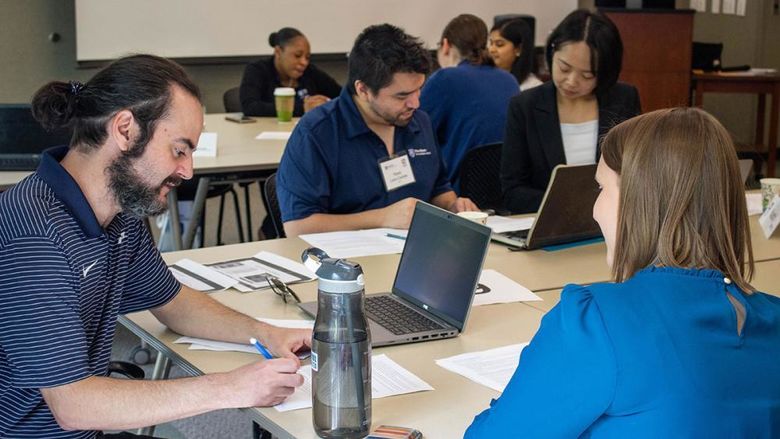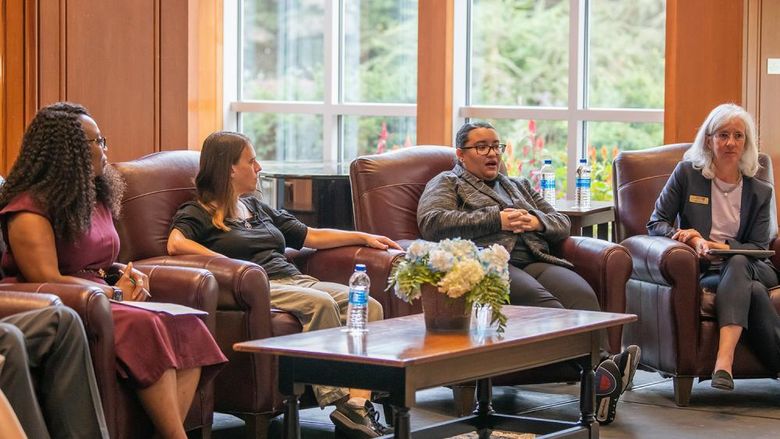
Mei-Ling Liber, doctoral student in biology, discusses her research with an attendee at the 2023 Graduate Exhibition, hosted by the Graduate School.
UNIVERSITY PARK, Pa. — Graduate student Rachel Duke was glad she registered for the 2023 Graduate Exhibition. She had never made a formal research presentation but knew the exhibition would give her an opportunity to hone this important skill. Plus, she had a second presentation to give the week after the Graduate Exhibition.
Duke’s research focuses on social inclusion in museums around the United States. She’s interested in understanding how museum curators are using strategies that enhance museum patrons’ sense of inclusion and belonging. Ultimately, Duke wants to better understand which of these strategies are effective so she can share them with the broader museum community to further improve social inclusion efforts.
“Presenting at the Exhibition helped me understand about scholarship and presentations in general in academia,” said Duke, a master’s student in education, development, and community engagement. “The week after the Exhibition, I presented my work at the Gamma Sigma Delta conference, and I felt so much more confident because I knew what was going to happen. The Graduate Exhibition helped me understand the expectations for a poster presentation.”
Duke is among the roughly 175 Penn State graduate students who presented their research, scholarship design or art at the poster and visual arts session of the 2023 Graduate Exhibition. Like Duke, many students walked away from the experience with more confidence, improved skills or a new way of looking at their work.
Getting initial feedback on results
Some students, like Flora Oswald, presented their work at the Graduate Exhibition because students can get feedback before publishing results. Oswald, a doctoral student in psychology with a dual title in women’s, gender, and sexuality studies, studies how people with minoritized body identities perceive threats and safety in their social world. She presented an unpublished study that used both qualitative methods to understand the experience of minoritized individuals and a quantitative method to understand how people encode visual information to make quick judgments of safety or threats.
By sharing her research at the Graduate Exhibition, Oswald was able to gauge the effectiveness of her presentation style.
“I tend to use a minimalistic style when I create my research posters, and I could see that some of the impact of my poster was lost when I presented to people outside my discipline. This helps me as I think about conveying my work to a general audience and whether I'm helping others to see the implications I see,” said Oswald.
Similarly, Debopriya Chakraborty presented some of her early results at the 2021 Graduate Exhibition, which was held virtually, and enjoyed the experience so much that she presented again in 2023 — this time in person.
“I wanted to get experience presenting my work to a greater audience, and not just a niche audience, and get practice presenting in lay person’s terms so that everyone can understand and not just people in my field,” she said.
Chakroborty, a pathobiology doctoral student, investigates the dietary effects of cruciferous vegetables like broccoli, and how these foods can have a positive effect on intestinal health. Her work focuses on characterizing the underlying biological and genetic mechanisms that allow for broccoli to have a positive impact on intestinal health.
A community of scholars
The broad nature of the Graduate Exhibition — students from more than 65 graduate programs exhibited projects this year — gives students and attendees a look at the array of research and academic projects taking place at the University.
“I hadn’t been to a conference since 2019, so I was excited for the in-person aspect of the Exhibition,” said Zaine Roberts, a master’s student in applied clinical psychology at Penn State Harrisburg. “When I go to conferences, I like to see what others are doing. Just from where I was set up at the Exhibition, I could see many of the online and in-person presentations.”
Roberts studies barriers to accessing gender-affirming health care during adolescence. Using health record data, he studies how long people wait and how far they travel to get access to care. He hopes to gather data that can dispel myths surrounding gender-affirming health care, and that can be used to inform policy making in the future.
Mei-Ling Liber, a first-year biology doctoral student, also showcased her research at the exhibition and walked away with an enhanced sense of community.
“I was very surprised by the amount of participation from people,” she said. “I saw people from my building who I didn’t expect to see, as well as everyone’s faculty PIs, so it really made me feel supported as a graduate student.”
Liber studies why herpes simplex virus is more virulent or severe in some people but not others. She is studying genetic differences between strains of the virus to pinpoint influential genes. By presenting at the Exhibition, Liber connected with other students and saw her research in a new light.
“Talking with other people about their research inspired me to think about my own research and different methods I could use. My neighbor at the Exhibition did research in proteomics, which I haven’t dealt with much, but we had a cross-talk and that was beneficial,” she said.
Roshnee Burma, a master’s student in applied clinical psychology at Penn State Harrisburg, had a similar experience. At the Graduate Exhibition, she presented a study exploring whether two factors — political ideology and knowing a family member or friend who suffers from an addiction — would impact a person’s view of addiction. Burma, who works with the Douglas W. Pollock Center for Addiction Outreach and Research, hopes to better understand stigma to improve future policy making. She said that talking with judges who were not from her discipline or who weren’t scientists helped her brainstorm next steps.
“The conversations I had helped me identify future research directions. The judges were very helpful and had good questions about my research methods. It was a learning opportunity more than anything else,” she said. “The whole experience was brilliant, and I would recommend it to all my fellow graduate students.”




